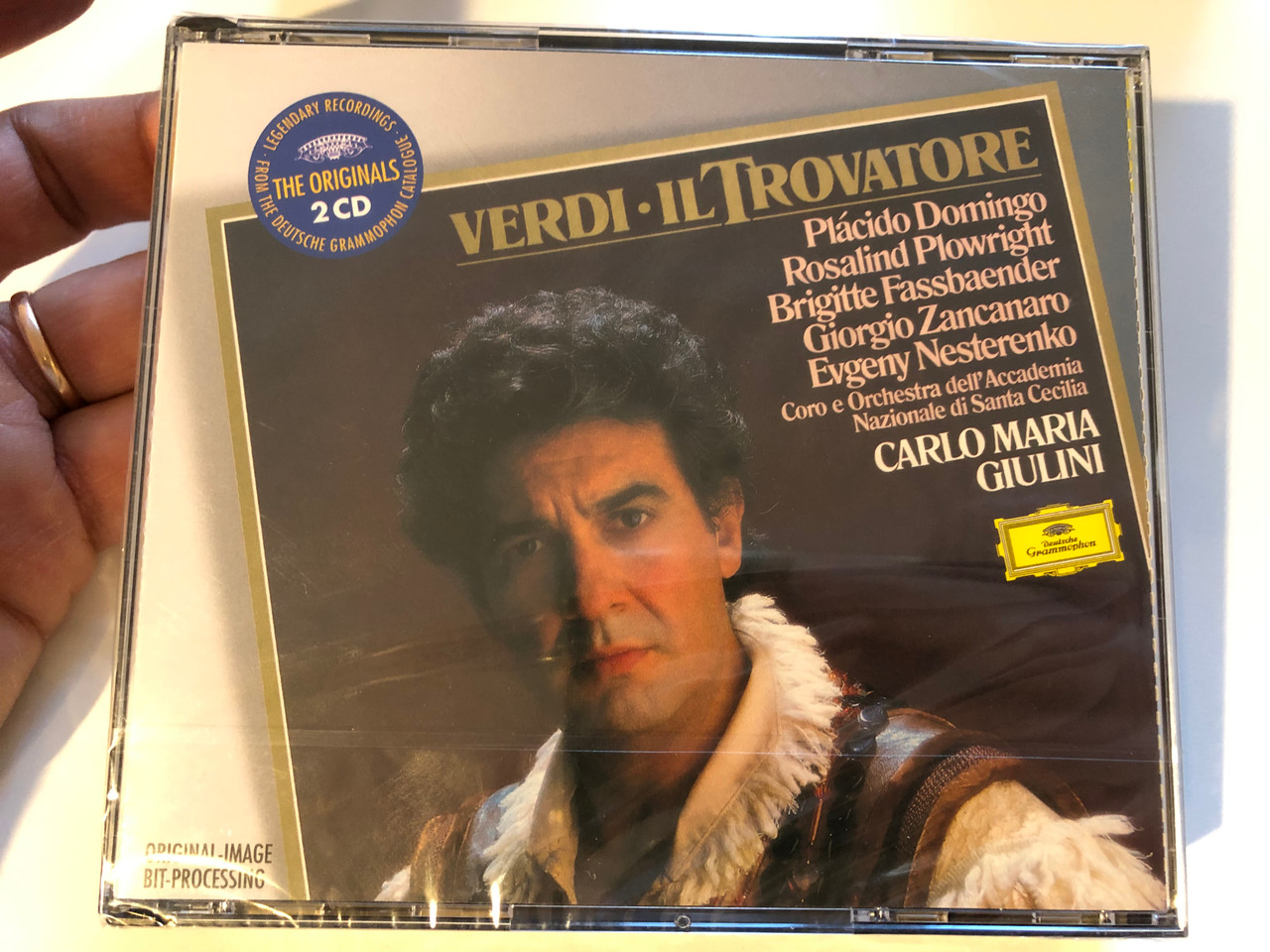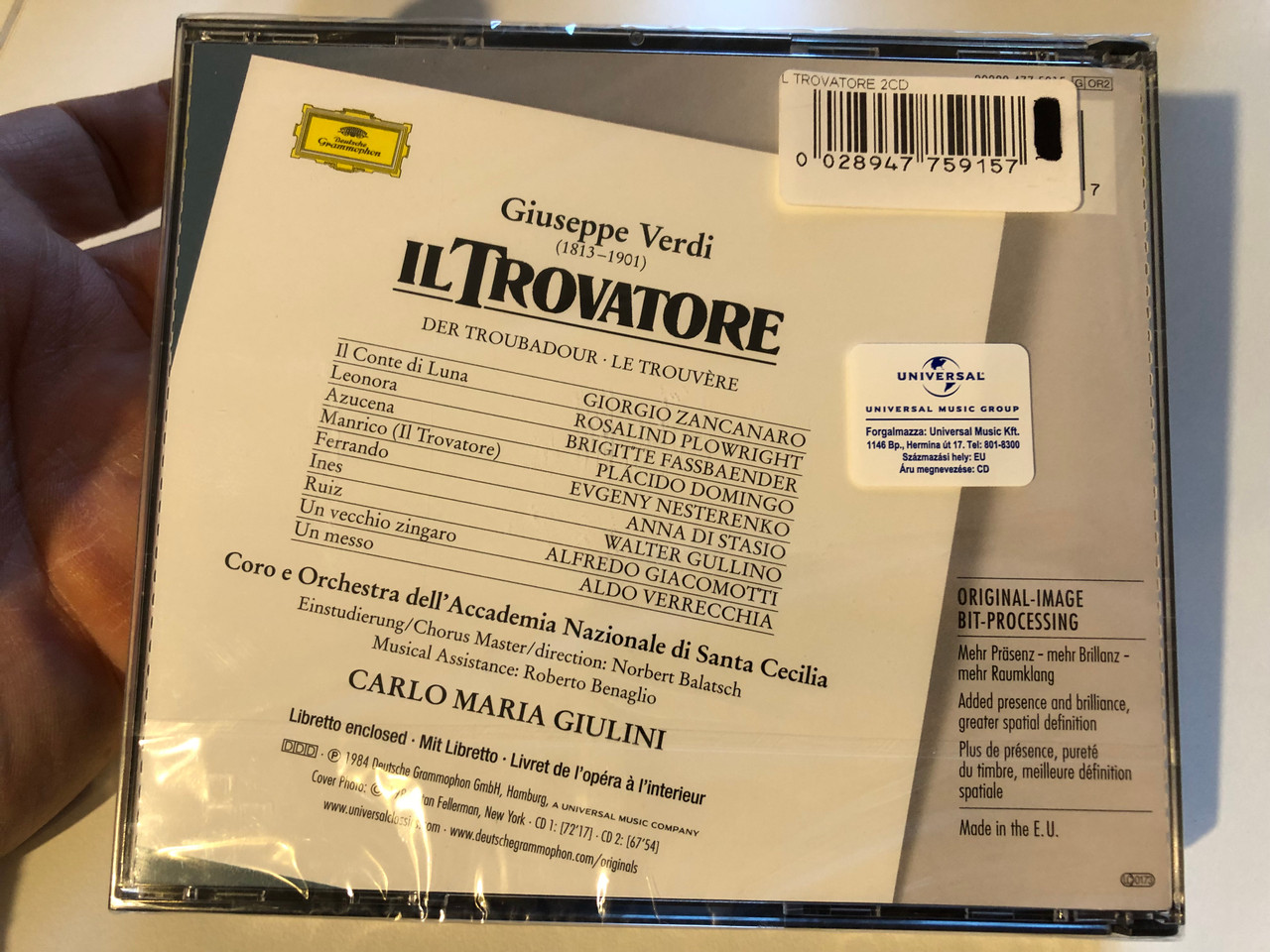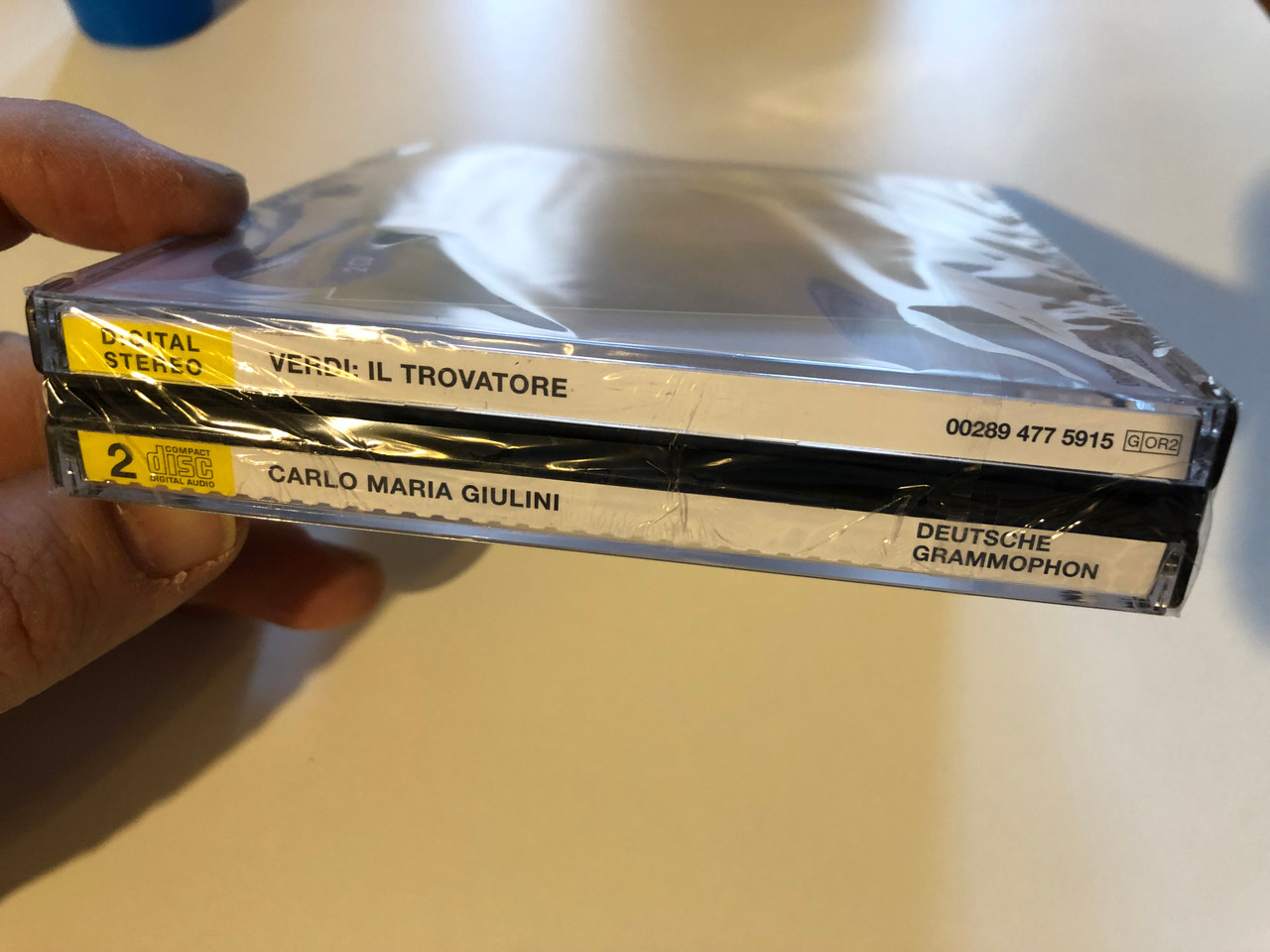Description
Verdi - Il Trovatore / Plácido Domingo, Rosalind Plowright, Brigitte Fassbaender, Giorgio Zancanaro, Evgeny Nesterenko, Coro E Orchestra Dell'Accademia Nazionale Di Santa Cecilia / Deutsche Grammophon 2x Audio CD Stereo / 00289 477 5915
UPC 0028947759157
Il trovatore ('The Troubadour') is an opera in four acts by Giuseppe Verdi to an Italian libretto largely written by Salvadore Cammarano, based on the play El trovador (1836) by Antonio García Gutiérrez. It was Gutiérrez's most successful play, one which Verdi scholar Julian Budden describes as "a high flown, sprawling melodrama flamboyantly defiant of the Aristotelian unities, packed with all manner of fantastic and bizarre incident."
The premiere took place at the Teatro Apollo in Rome on 19 January 1853, where it "began a victorious march throughout the operatic world," a success due to Verdi's work over the previous three years. It began with his January 1850 approach to Cammarano with the idea of Il trovatore. There followed, slowly and with interruptions, the preparation of the libretto, first by Cammarano until his death in mid-1852 and then with the young librettist Leone Emanuele Bardare, which gave the composer the opportunity to propose significant revisions, which were accomplished under his direction. These revisions are seen largely in the expansion of the role of Leonora.
For Verdi, the three years were filled with musical activity; work on this opera did not proceed while the composer wrote and premiered Rigoletto in Venice in March 1851. His personal affairs also limited his professional work. In May 1851, an additional commission was offered by the Venice company after Rigoletto's success there. Another commission came from Paris while he was visiting that city from late 1851 to March 1852. Before the libretto for Il trovatore was completed, before it was scored, and before it premiered, Verdi had four operatic projects in various stages of development.
Today, Il trovatore is performed frequently and is a staple of the standard operatic repertoire.
| Label: | Deutsche Grammophon – 00289 477 5915 |
|---|---|
| Series: | The Originals |
| Format: |
2 x CD, Album
|
| Country: | Europe |
| Released: |
|
| Genre: | Classical |
| Style: | Romantic, Opera |
Tracklist:
| Parte Prima = Erster Teil = Part I = Première Partie | |||
| Quadro Primo = Erstes Bild = Scene 1 = Scène 1 | |||
| 1-1 | 1. Introduzione: "All'erta! All'erta!" (Ferrando, Familiari, Armigeri) | 3:09 | |
| 1-2 | "Di Due Figli Vivea Padre Beato ... Abbitta Zingara..." – "Sull'orlo Dei Tetti" (Ferrando, Familiari, Armigeri) | 8:17 | |
|
Quadro Secondo = Zweites Bild = Scene 2 = Scène 2 |
|||
| 1-3 | 2. Scena E Cavatina: "Che Piú T'Arresti?" (Ines, Leonora) | 2:26 | |
| 1-4 | "Tacea La Notte Placida ... Di Tale Amor" (Leonora, Ines) | 7:30 | |
| 1-5 | 3. Scena, Romanza E Terzetto: "Tace La Notte!" (Conte) | 1:55 | |
| 1-6 | "Deserto Sulla Terra" (Manrico, Conte) | 1:54 | |
| 1-7 | "Non M'inganno... Ella Scende! ... Di Geloso Amor" (Conte, Leonora, Manrico) | 4:40 | |
|
Parte Seconda = Zweiter Teil = Part II = Deuxième Partie |
|||
| Quadro Primo = Erstes Bild = Scene 1 = Scène 1 | |||
| 1-8 | 4. Coro Di Zingari E Canzone: "Vedi! Le Fosche Notturne Spoglie" (Zingari, Zingare) | 2:52 | |
| 1-9 | "Stride La Vampa!" (Azucena) | 2:43 | |
| 1-10 | "Mesta É La Tua Canzon!" (Zingare, Zingari, Azucena, Manrico, Un Vecchio Zingaro) | 1:56 | |
| 1-11 | 5. Scena E Racconto: "Soli Or Siam!" (Manrico, Azucena) | 0:58 | |
| 1-12 | "Condotta Ell'era In Ceppi" (Azucena, Manrico) | 5:08 | |
| 1-13 | 6. Scena E Duetto: "Non Son Tuo Figlio?" (Manrico, Azucena) | 2:15 | |
| 1-14 | "Mal Reggendo All'aspro Assalto" (Manrico, Azucena, Un Messo) | 7:08 | |
|
Quadro Secondo = Zweites Bild = Scene 2 = Scène 2 |
|||
| 1-15 | 7. Scena Ed Aria: "Tutto É Deserto" (Conte, Ferrando) | 1:32 | |
| 1-16 | "Il Balen Del Suo Sorriso ... Per Me, Ora Fatale" (Conte, Ferrando, Seguaci) | 7:35 | |
| 1-17 | 8. Finale Secondo: "Ah! Se L'error T'ingombra" (Religiose, Conte, Ferrando, Seguaci) | 2:48 | |
| 1-18 | "Perché Pinagete?" (Leonora, Ines, Conte, Religiose) | 2:19 | |
| 1-19 | "E Deggio... E Posso Crederlo?" (Leonora, Conte, Manrico, Ferrando, Sequaci, Ines, Religiouse, Ruiz, Armati) | 4:50 | |
|
Parte Terza = Dritter Teil = Part III = Troisième Partie |
|||
| Quadro Primo = Erstes Bild = Scene 1 = Scène 1 | |||
| 2-1 | 9. Coro D'introduzione: "Or Co' Dadi ... Squilli, Echeggi La Tromba Guerriera" (Armigeri, Ferrando) | 4:56 | |
| 2-2 | 10. Scena E Terzetto: "In Braccio Al Mio Rival!" (Conte, Ferrando, Soldati, Azucena) | 2:18 | |
| 2-3 | "Giorni Poveri Vivea" (Azucena, Ferrando, Conte, Soldati) | 5:11 | |
|
Quadro Secondo = Zweites Bild = Scene 2 = Scène 2 |
|||
| 2-4 | 11. Scena Ed Aria: "Quale D'armi Fragor Poc'anzi Intensi?" (Leonora, Manrico) | 2:09 | |
| 2-5 | "Ah Si, Ben Mio" (Manrico) | 3:25 | |
| 2-6 | "L'onda De' Suoni Mistici" (Leonora, Manrico) | 0:50 | |
| 2-7 | "Manrico?" – "Che?" – "La Zingara" (Ruiz, Manrico, Leonora) | 0:47 | |
| 2-8 | "Di Quella Pira" (Manrico, Leonora, Ruiz, Armati) | 3:42 | |
|
Parte Quarta = Vierter Teil = Part IV = Quatrième Partie |
|||
| Quadro Primo = Erstes Bild = Scene 1 = Scène 1 | |||
| 2-9 | 12. Scena, Aria E Misere: "Siam Giunti" (Ruiz, Leonora) | 2:58 | |
| 2-10 | "D'amor Sull'ali Rosee" (Leonora) | 4:05 | |
| 2-11 | "Miserere - "Ah! Che La Morte Ognora..." (Voca Interne, Leonora, Manrico) | 5:29 | |
| 2-12 | "Tu Vedrai Che Amore In Terra" (Leonora) | 4:17 | |
| 2-13 | 13. Scena E Duetto: "Udiste? Come Albeggi" (Conte, Leonora) | 1:00 | |
| 2-14 | "Qual Voce!" – "Mira, Di Acerbe Lagrime... Vivrà! Contende Il Giubilo" (Conte, Leonora) | 7:00 | |
|
Quadro Secondo = Zweites Bild = Scene 2 = Scène 2 |
|||
| 2-15 | "Madre, Non Dormi?" – "Ai Nostri Monti" (Manrico, Azucena) | 9:29 | |
| 2-16 | "Che!... Non M'inganna Quel Fioco Lume? ... Ha Quest'infame L'amor Venduto..." (Manrico, Leonora, Azucena) |
4:59 | |
| 2-17 | "Ti Scota!" – "Non Respingermi" (Manrico, Leonora, Conte, Azucena) | 4:56 |
- Art Direction – Philipp Starke
- Baritone Vocals [Il Conte di Luna] – Giorgio Zancanaro
- Baritone Vocals [Un Messo] – Aldo Verrecchia
- Bass Vocals [Ferrando] – Evgeny Nesterenko
- Bass Vocals [Un Vecchio Zingaro] – Alfredo Giacomotti
- Booklet Editor – Angela Schumacher
- Choir – Coro Dell'Accademia Nazionale Di Santa Cecilia
- Chorus Master – Norbert Balatsch
- Composed By – Giuseppe Verdi
- Conductor – Carlo Maria Giulini
- Coordinator [Coordination] – Claudia Hamann
- Engineer [Recording Engineer] – Jobst Eberhardt
- Engineer [Recording Engineer], Edited By [Editing] – Klaus Behrens
- Engineer [Tonmeister (Balance Engineer)] – Klaus Scheibe
- Executive-Producer – Günther Breest
- Liner Notes – Alan Blyth
- Liner Notes [L'Action Traduction] – François Papet-Périn
- Liner Notes [Synopsis] – Roger Parker (5)
- Liner Notes [Traduction] – Dennis Collins (2)
- Liner Notes [Übersetzung] – Reinhard Lüthje
- Mezzo-soprano Vocals [Azucena] – Brigitte Fassbaender
- Mezzo-soprano Vocals [Ines] – Anna Di Stasio
- Musical Assistance – Roberto Benaglio
- Orchestra – Orchestra Dell'Accademia Nazionale Di Santa Cecilia
- Photography By [Artist Photos - Domingo] – Clive Barda
- Photography By [Artist Photos - Plowright] – Fritz Curzon, London
- Photography By [Artist Photos] – Silvia Lelli Masotti
- Photography By, Cover – Stan Fellerman, New York
- Producer [Recording Producer] – Hans Weber
- Project Manager [Project Management] – Alan Newcombe
- Soprano Vocals [Leonora] – Rosalind Plowright
- Tenor Vocals [Manrico (Il Trovatore)] – Plácido Domingo
- Tenor Vocals [Ruiz] – Walter Gullino


























